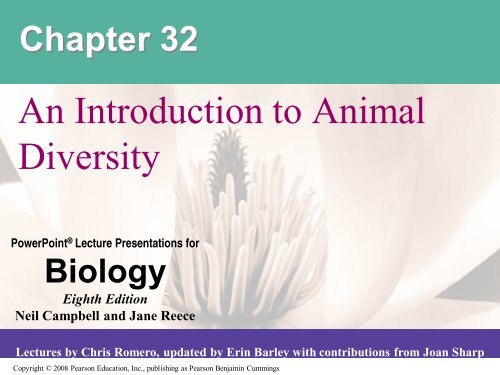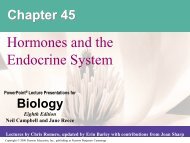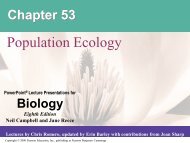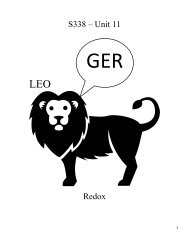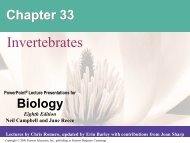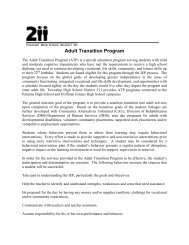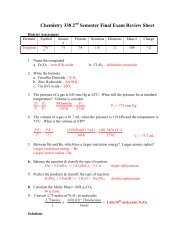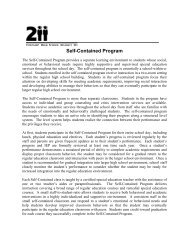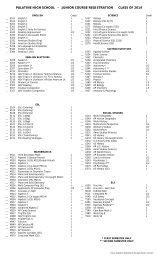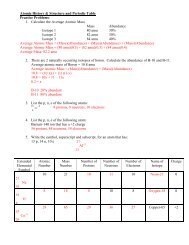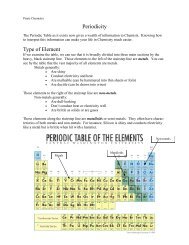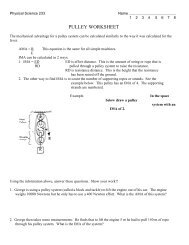Ch 32 PPT
Ch 32 PPT
Ch 32 PPT
Create successful ePaper yourself
Turn your PDF publications into a flip-book with our unique Google optimized e-Paper software.
<strong>Ch</strong>apter <strong>32</strong><br />
An Introduction to Animal<br />
Diversity<br />
PowerPoint ® Lecture Presentations for<br />
Biology<br />
Eighth Edition<br />
Neil Campbell and Jane Reece<br />
Lectures by <strong>Ch</strong>ris Romero, updated by Erin Barley with contributions from Joan Sharp<br />
Copyright © 2008 Pearson Education, Inc., publishing as Pearson Benjamin Cummings
Overview: Welcome to Your Kingdom<br />
• The animal kingdom extends far beyond<br />
humans and other animals we may encounter<br />
• 1.3 million living species of animals have been<br />
identified<br />
Video: Coral Reef<br />
Copyright © 2008 Pearson Education, Inc., publishing as Pearson Benjamin Cummings
Fig. <strong>32</strong>-1
Concept <strong>32</strong>.1: Animal are multicellular,<br />
heterotrophic eukaryotes with tissues that develop<br />
from embryonic layers<br />
• There are exceptions to nearly every criterion<br />
for distinguishing animals from other life-forms<br />
• Several characteristics, taken together,<br />
sufficiently define the group<br />
Copyright © 2008 Pearson Education, Inc., publishing as Pearson Benjamin Cummings
Nutritional Mode<br />
• Animals are heterotrophs that ingest their food<br />
Copyright © 2008 Pearson Education, Inc., publishing as Pearson Benjamin Cummings
Cell Structure and Specialization<br />
• Animals are multicellular eukaryotes<br />
• Their cells lack cell walls<br />
• Their bodies are held together by structural<br />
proteins such as collagen<br />
• Nervous tissue and muscle tissue are unique to<br />
animals<br />
Copyright © 2008 Pearson Education, Inc., publishing as Pearson Benjamin Cummings
Reproduction and Development<br />
• Most animals reproduce sexually, with the<br />
diploid stage usually dominating the life cycle<br />
• After a sperm fertilizes an egg, the zygote<br />
undergoes rapid cell division called cleavage<br />
• Cleavage leads to formation of a blastula<br />
• The blastula undergoes gastrulation, forming<br />
a gastrula with different layers of embryonic<br />
tissues<br />
Video: Sea Urchin Embryonic Development<br />
Copyright © 2008 Pearson Education, Inc., publishing as Pearson Benjamin Cummings
Fig. <strong>32</strong>-2-1<br />
Cleavage<br />
Zygote<br />
Eight-cell stage
Fig. <strong>32</strong>-2-2<br />
Cleavage<br />
Cleavage Blastula<br />
Zygote<br />
Eight-cell stage<br />
Cross section<br />
of blastula<br />
Blastocoel
Fig. <strong>32</strong>-2-3<br />
Blastocoel<br />
Cleavage<br />
Cleavage Blastula<br />
Endoderm<br />
Ectoderm<br />
Zygote<br />
Eight-cell stage<br />
Archenteron<br />
Gastrulation<br />
Gastrula<br />
Blastocoel Blastopore<br />
Cross section<br />
of blastula
• Many animals have at least one larval stage<br />
• A larva is sexually immature and<br />
morphologically distinct from the adult; it<br />
eventually undergoes metamorphosis<br />
Copyright © 2008 Pearson Education, Inc., publishing as Pearson Benjamin Cummings
• All animals, and only animals, have Hox genes<br />
that regulate the development of body form<br />
• Although the Hox family of genes has been<br />
highly conserved, it can produce a wide<br />
diversity of animal morphology<br />
Copyright © 2008 Pearson Education, Inc., publishing as Pearson Benjamin Cummings
Concept <strong>32</strong>.2: The history of animals spans more<br />
than half a billion years<br />
• The animal kingdom includes a great diversity<br />
of living species and an even greater diversity<br />
of extinct ones<br />
• The common ancestor of living animals may<br />
have lived between 675 and 875 million years<br />
ago<br />
• This ancestor may have resembled modern<br />
choanoflagellates, protists that are the closest<br />
living relatives of animals<br />
Copyright © 2008 Pearson Education, Inc., publishing as Pearson Benjamin Cummings
Fig. <strong>32</strong>-3<br />
Individual<br />
choanoflagellate<br />
<strong>Ch</strong>oanoflagellates<br />
OTHER<br />
EUKARYOTES<br />
Sponges<br />
Animals<br />
Other animals<br />
Collar cell<br />
(choanocyte)
Neoproterozoic Era (1 Billion–524 Million Years<br />
Ago)<br />
• Early members of the animal fossil record<br />
include the Ediacaran biota, which dates from<br />
565 to 550 million years ago<br />
Copyright © 2008 Pearson Education, Inc., publishing as Pearson Benjamin Cummings
Fig. <strong>32</strong>-4<br />
1.5 cm 0.4 cm<br />
(a) Mawsonites spriggi<br />
(b) Spriggina floundersi
Fig. <strong>32</strong>-4a<br />
1.5 cm<br />
(a) Mawsonites spriggi
Fig. <strong>32</strong>-4b<br />
0.4 cm<br />
(b) Spriggina floundersi
Paleozoic Era (542–251 Million Years Ago)<br />
• The Cambrian explosion (535 to 525 million<br />
years ago) marks the earliest fossil appearance<br />
of many major groups of living animals<br />
• There are several hypotheses regarding the<br />
cause of the Cambrian explosion<br />
– New predator-prey relationships<br />
– A rise in atmospheric oxygen<br />
– The evolution of the Hox gene complex<br />
Copyright © 2008 Pearson Education, Inc., publishing as Pearson Benjamin Cummings
Fig. <strong>32</strong>-5
• Animal diversity continued to increase through<br />
the Paleozoic, but was punctuated by mass<br />
extinctions<br />
• Animals began to make an impact on land by<br />
460 million years ago<br />
• Vertebrates made the transition to land around<br />
360 million years ago<br />
Copyright © 2008 Pearson Education, Inc., publishing as Pearson Benjamin Cummings
Mesozoic Era (251–65.5 Million Years Ago)<br />
• Coral reefs emerged, becoming important<br />
marine ecological niches for other organisms<br />
• During the Mesozoic era, dinosaurs were the<br />
dominant terrestrial vertebrates<br />
• The first mammals emerged<br />
Copyright © 2008 Pearson Education, Inc., publishing as Pearson Benjamin Cummings
Cenozoic Era (65.5 Million Years Ago to the<br />
Present)<br />
• The beginning of the Cenozoic era followed<br />
mass extinctions of both terrestrial and marine<br />
animals<br />
• These extinctions included the large, nonflying<br />
dinosaurs and the marine reptiles<br />
• Modern mammal orders and insects diversified<br />
during the Cenozoic<br />
Copyright © 2008 Pearson Education, Inc., publishing as Pearson Benjamin Cummings
Concept <strong>32</strong>.3: Animals can be characterized by<br />
“body plans”<br />
• Zoologists sometimes categorize animals<br />
according to a body plan, a set of<br />
morphological and developmental traits<br />
• A grade is a group whose members share key<br />
biological features<br />
• A grade is not necessarily a clade, or<br />
monophyletic group<br />
Copyright © 2008 Pearson Education, Inc., publishing as Pearson Benjamin Cummings
Fig. <strong>32</strong>-6<br />
RESULTS<br />
100 µm<br />
Site of<br />
gastrulation<br />
Site of<br />
gastrulation
Fig. <strong>32</strong>-6a<br />
RESULTS<br />
100 µm
Fig. <strong>32</strong>-6b<br />
RESULTS<br />
Site of<br />
gastrulation
Fig. <strong>32</strong>-6c<br />
RESULTS<br />
Site of<br />
gastrulation
Fig. <strong>32</strong>-6d<br />
RESULTS
Symmetry<br />
• Animals can be categorized according to the<br />
symmetry of their bodies, or lack of it<br />
• Some animals have radial symmetry<br />
Copyright © 2008 Pearson Education, Inc., publishing as Pearson Benjamin Cummings
Fig. <strong>32</strong>-7<br />
(a) Radial symmetry<br />
(b) Bilateral symmetry
• Two-sided symmetry is called bilateral<br />
symmetry<br />
• Bilaterally symmetrical animals have:<br />
– A dorsal (top) side and a ventral (bottom) side<br />
– A right and left side<br />
– Anterior (head) and posterior (tail) ends<br />
– Cephalization, the development of a head<br />
Copyright © 2008 Pearson Education, Inc., publishing as Pearson Benjamin Cummings
Tissues<br />
• Animal body plans also vary according to the<br />
organization of the animal’s tissues<br />
• Tissues are collections of specialized cells<br />
isolated from other tissues by membranous<br />
layers<br />
• During development, three germ layers give<br />
rise to the tissues and organs of the animal<br />
embryo<br />
Copyright © 2008 Pearson Education, Inc., publishing as Pearson Benjamin Cummings
• Ectoderm is the germ layer covering the<br />
embryo’s surface<br />
• Endoderm is the innermost germ layer and<br />
lines the developing digestive tube, called the<br />
archenteron<br />
• Diploblastic animals have ectoderm and<br />
endoderm<br />
• Triploblastic animals also have an intervening<br />
mesoderm layer; these include all bilaterians<br />
Copyright © 2008 Pearson Education, Inc., publishing as Pearson Benjamin Cummings
Body Cavities<br />
• Most triploblastic animals possess a body<br />
cavity<br />
• A true body cavity is called a coelom and is<br />
derived from mesoderm<br />
• Coelomates are animals that possess a true<br />
coelom<br />
Copyright © 2008 Pearson Education, Inc., publishing as Pearson Benjamin Cummings
Fig. <strong>32</strong>-8<br />
Coelom<br />
Body covering<br />
(from ectoderm)<br />
Digestive tract<br />
(from endoderm)<br />
Tissue layer<br />
lining coelom<br />
and suspending<br />
internal organs<br />
(from mesoderm)<br />
(a) Coelomate<br />
Pseudocoelom<br />
(b) Pseudocoelomate<br />
Digestive tract<br />
(from endoderm)<br />
Body covering<br />
(from ectoderm)<br />
Muscle layer<br />
(from<br />
mesoderm)<br />
Body covering<br />
(from ectoderm)<br />
Tissuefilled<br />
region<br />
(from<br />
mesoderm)<br />
Wall of digestive cavity<br />
(from endoderm)<br />
(c) Acoelomate
Fig. <strong>32</strong>-8a<br />
Coelom<br />
Body covering<br />
(from ectoderm)<br />
Digestive tract<br />
(from endoderm)<br />
Tissue layer<br />
lining coelom<br />
and suspending<br />
internal organs<br />
(from mesoderm)<br />
(a) Coelomate
• A pseudocoelom is a body cavity derived from<br />
the mesoderm and endoderm<br />
• Triploblastic animals that possess a<br />
pseudocoelom are called pseudocoelomates<br />
Copyright © 2008 Pearson Education, Inc., publishing as Pearson Benjamin Cummings
Fig. <strong>32</strong>-8b<br />
Body covering<br />
(from ectoderm)<br />
Pseudocoelom<br />
Digestive tract<br />
(from endoderm)<br />
Muscle layer<br />
(from<br />
mesoderm)<br />
(b) Pseudocoelomate
• Triploblastic animals that lack a body cavity are<br />
called acoelomates<br />
Copyright © 2008 Pearson Education, Inc., publishing as Pearson Benjamin Cummings
Fig. <strong>32</strong>-8c<br />
Body covering<br />
(from ectoderm)<br />
Tissuefilled<br />
region<br />
(from<br />
mesoderm)<br />
Wall of digestive cavity<br />
(from endoderm)<br />
(c) Acoelomate
Protostome and Deuterostome Development<br />
• Based on early development, many animals<br />
can be categorized as having protostome<br />
development or deuterostome development<br />
Copyright © 2008 Pearson Education, Inc., publishing as Pearson Benjamin Cummings
Cleavage<br />
• In protostome development, cleavage is spiral<br />
and determinate<br />
• In deuterostome development, cleavage is<br />
radial and indeterminate<br />
• With indeterminate cleavage, each cell in the<br />
early stages of cleavage retains the capacity to<br />
develop into a complete embryo<br />
• Indeterminate cleavage makes possible<br />
identical twins, and embryonic stem cells<br />
Copyright © 2008 Pearson Education, Inc., publishing as Pearson Benjamin Cummings
Fig. <strong>32</strong>-9<br />
Protostome development<br />
(examples: molluscs,<br />
annelids)<br />
Eight-cell stage<br />
Deuterostome development<br />
(examples: echinoderm,<br />
chordates)<br />
Eight-cell stage<br />
(a) Cleavage<br />
Key<br />
Ectoderm<br />
Mesoderm<br />
Endoderm<br />
Spiral and determinate<br />
Radial and indeterminate<br />
Coelom<br />
Archenteron<br />
Coelom<br />
Mesoderm Blastopore Blastopore Mesoderm<br />
Solid masses of mesoderm<br />
split and form coelom.<br />
Folds of archenteron<br />
form coelom.<br />
Anus<br />
Mouth<br />
(b) Coelom formation<br />
(c) Fate of the blastopore<br />
Digestive tube<br />
Mouth<br />
Mouth develops from blastopore.<br />
Anus<br />
Anus develops from blastopore.
Fig. <strong>32</strong>-9a<br />
Protostome development<br />
(examples: molluscs,<br />
annelids)<br />
Eight-cell stage<br />
Deuterostome development<br />
(examples: echinoderms,<br />
chordates)<br />
Eight-cell stage<br />
(a) Cleavage<br />
Spiral and determinate<br />
Radial and indeterminate
Coelom Formation<br />
• In protostome development, the splitting of<br />
solid masses of mesoderm forms the coelom<br />
• In deuterostome development, the mesoderm<br />
buds from the wall of the archenteron to form<br />
the coelom<br />
Copyright © 2008 Pearson Education, Inc., publishing as Pearson Benjamin Cummings
Fig. <strong>32</strong>-9b<br />
Protostome development<br />
(examples: molluscs,<br />
annelids)<br />
Deuterostome development<br />
(examples: echinoderms,<br />
chordates)<br />
Coelom<br />
Coelom<br />
Archenteron<br />
Mesoderm Blastopore Blastopore Mesoderm<br />
Solid masses of mesoderm Folds of archenteron<br />
split and form coelom.<br />
form coelom.<br />
(b) Coelom formation<br />
Key<br />
Ectoderm<br />
Mesoderm<br />
Endoderm
Fate of the Blastopore<br />
• The blastopore forms during gastrulation and<br />
connects the archenteron to the exterior of the<br />
gastrula<br />
• In protostome development, the blastopore<br />
becomes the mouth<br />
• In deuterostome development, the blastopore<br />
becomes the anus<br />
Copyright © 2008 Pearson Education, Inc., publishing as Pearson Benjamin Cummings
Fig. <strong>32</strong>-9c<br />
Protostome development<br />
(examples: molluscs,<br />
annelids)<br />
Deuterostome development<br />
(examples: echinoderms,<br />
chordates)<br />
Anus<br />
Digestive tube<br />
Mouth<br />
(c) Fate of the blastopore<br />
Key<br />
Ectoderm<br />
Mesoderm<br />
Endoderm<br />
Mouth<br />
Anus<br />
Mouth develops from blastopore. Anus develops from blastopore.
Concept <strong>32</strong>.4: New views of animal phylogeny are<br />
emerging from molecular data<br />
• Zoologists recognize about three dozen animal<br />
phyla<br />
• Current debate in animal systematics has led<br />
to the development of two phylogenetic<br />
hypotheses, but others exist as well<br />
Copyright © 2008 Pearson Education, Inc., publishing as Pearson Benjamin Cummings
• One hypothesis of animal phylogeny is based<br />
mainly on morphological and developmental<br />
comparisons<br />
Copyright © 2008 Pearson Education, Inc., publishing as Pearson Benjamin Cummings
Fig. <strong>32</strong>-10<br />
“Porifera”<br />
ANCESTRAL<br />
COLONIAL<br />
FLAGELLATE<br />
Metazoa<br />
Eumetazoa<br />
Bilateria<br />
Deuterostomia Protostomia<br />
Cnidaria<br />
Ctenophora<br />
Ectoprocta<br />
Brachiopoda<br />
Echinodermata<br />
<strong>Ch</strong>ordata<br />
Platyhelminthes<br />
Rotifera<br />
Mollusca<br />
Annelida<br />
Arthropoda<br />
Nematoda
• One hypothesis of animal phylogeny is based<br />
mainly on molecular data<br />
Copyright © 2008 Pearson Education, Inc., publishing as Pearson Benjamin Cummings
Fig. <strong>32</strong>-11<br />
ANCESTRAL<br />
COLONIAL<br />
FLAGELLATE<br />
Metazoa<br />
Eumetazoa<br />
“Porifera”<br />
Silicea<br />
Calcarea<br />
Ctenophora<br />
Cnidaria<br />
Acoela<br />
Bilateria<br />
Deuterostomia<br />
Echinodermata<br />
<strong>Ch</strong>ordata<br />
Platyhelminthes<br />
Lophotrochozoa Ecdysozoa<br />
Rotifera<br />
Ectoprocta<br />
Brachiopoda<br />
Mollusca<br />
Annelida<br />
Nematoda<br />
Arthropoda
Points of Agreement<br />
• All animals share a common ancestor<br />
• Sponges are basal animals<br />
• Eumetazoa is a clade of animals<br />
(eumetazoans) with true tissues<br />
• Most animal phyla belong to the clade Bilateria,<br />
and are called bilaterians<br />
• <strong>Ch</strong>ordates and some other phyla belong to the<br />
clade Deuterostomia<br />
Copyright © 2008 Pearson Education, Inc., publishing as Pearson Benjamin Cummings
Progress in Resolving Bilaterian Relationships<br />
• The morphology-based tree divides bilaterians<br />
into two clades: deuterostomes and<br />
protostomes<br />
• In contrast, recent molecular studies indicate<br />
three bilaterian clades: Deuterostomia,<br />
Ecdysozoa, and Lophotrochozoa<br />
• Ecdysozoans shed their exoskeletons through<br />
a process called ecdysis<br />
Copyright © 2008 Pearson Education, Inc., publishing as Pearson Benjamin Cummings
Fig. <strong>32</strong>-12
• Some lophotrochozoans have a feeding<br />
structure called a lophophore<br />
• Other phyla go through a distinct<br />
developmental stage called the trochophore<br />
larva<br />
Copyright © 2008 Pearson Education, Inc., publishing as Pearson Benjamin Cummings
Fig. <strong>32</strong>-13<br />
Lophophore<br />
Apical tuft<br />
of cilia<br />
Mouth<br />
100 µm<br />
Anus<br />
(a) An ectoproct<br />
(b) Structure of a trochophore<br />
larva
Future Directions in Animal Systematics<br />
• Phylogenetic studies based on larger<br />
databases will likely provide further insights<br />
into animal evolutionary history<br />
Copyright © 2008 Pearson Education, Inc., publishing as Pearson Benjamin Cummings
Fig. <strong>32</strong>-UN1<br />
Common ancestor<br />
of all animals<br />
Sponges<br />
(basal animals)<br />
Ctenophora<br />
Cnidaria<br />
Eumetazoa<br />
Metazoa<br />
True<br />
tissues<br />
Bilateral<br />
summetry<br />
Three germ<br />
layers<br />
Acoela (basal<br />
bilaterians)<br />
Deuterostomia<br />
Lophotrochozoa<br />
Ecdysozoa<br />
Bilateria (most animals)
Fig. <strong>32</strong>-T1
Fig. <strong>32</strong>-UN2
You should now be able to:<br />
1. List the characteristics that combine to define<br />
animals<br />
2. Summarize key events of the Paleozoic,<br />
Mesozoic, and Cenozoic eras<br />
3. Distinguish between the following pairs or sets<br />
of terms: radial and bilateral symmetry; grade<br />
and clade of animal taxa; diploblastic and<br />
triploblastic; spiral and radial cleavage;<br />
determinate and indeterminate cleavage;<br />
acoelomate, pseudocoelomate, and<br />
coelomate grades<br />
Copyright © 2008 Pearson Education, Inc., publishing as Pearson Benjamin Cummings
4. Compare the developmental differences<br />
between protostomes and deuterostomes<br />
5. Compare the alternate relationships of<br />
annelids and arthropods presented by two<br />
different proposed phylogenetic trees<br />
6. Distinguish between ecdysozoans and<br />
lophotrochozoans<br />
Copyright © 2008 Pearson Education, Inc., publishing as Pearson Benjamin Cummings


